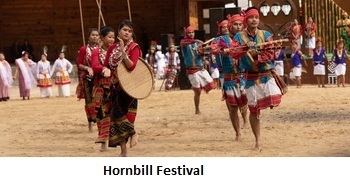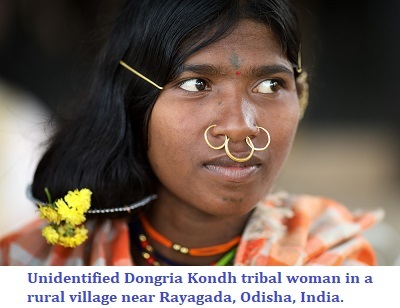

Tribes in India can be categorised into many on the basis of their socio-economic, geographical and distinctive features. Some of these features include their dialect, religion, food habits, clothing, lifestyle, livelihood, racial features, geographical locations and politics. They can be studied from many fields of social science but this kind of extensive study is only possible through anthropology which will be our mode of discussing the tribes in this article.
Some of these features include their dialect, religion, food habits, clothing, lifestyle, livelihood, racial features, geographical locations and politics. They can be studied from many fields of social science but this kind of extensive study is only possible through anthropology which will be our mode of discussing the tribes in this article.
According to anthropological study there are 693 Scheduled Tribes in India, 1500 Nomadic and Semi-Nomadic Tribes, 150 Denotified Tribes and 75 Particularly Vulnerable Tribal Groups. It is estimated that till today there are several tribes who are living in extremely poor conditions in India.
Experts argue due to extreme geographical conditions several governmental schemes do not reach them. Others argue that they are still not included in these schemes. Their economy is considered primitive and their literacy very low. Some experts also claim that there is a constant clash between some tribal groups in India and the government authorities in relation to development plans. Due to rapid industrialization they have become conscious about their cultural identity, geographical location which lead to protest against various government developmental schemes.
The characteristics of genes of the tribes based in central India show similarity with tribes of South India. These include racial origins like Dravidian, Eastern, Indo-European and Austro-Asiatic. The North-Indian tribe belongs to the Indo-European, Tibeto-Burman and Austro-Asicatic group of families. There are also tribes that show specific genetic features different from the Indian tribes. These tribes include more than 100 Naga tribes and Hmar tribes. Due to their genetic differences, there also exists linguistic differences.
In addition to being categorised by area, tribes are also categorised by language. The tribes of India can be divided into four major linguistic groups: Indo-Aryan, Austro-Asiatic, Dravidian, and Tibeto-Burman.
The Dravidian language family includes all of the tribes in southern India, including Gonds and Oraons of central India. This language family includes the Gondi language used by the Gonds who migrated from Maharashtra to Orissa and from Uttar Pradesh to Andhra Pradesh. The Kurukh language, spoken by the Oraons of central India, the Tulu language, spoken by the Malerus of Karnataka are some of languages in this family.
The Austric language family is the one spoken by the Khasis and Jaintias of Meghalaya. Apart from them, people who speak Austric or Mundarian languages include the Mundas (Bihar), Santhals (West Bengal, Bihar, Orissa, and Tripura), Hos (Bihar, Orissa, West Bengal, and Madhya Pradesh), Saoras (Andhra Pradesh, West Bengal, Madhya Pradesh, Bihar, and Orissa), Bondos (Orissa), etc.

The Indo-Aryan language family is spoken by the tribes in Gujarat, Rajasthan, and the Indo-Gangetic Plain. They include Chattisgarhi, Gujarati, Marathi, Assamese, Oriya, the language spoken by the Baigas, Banjari by the Banjaras, Bhili by the Bhils, Dardic by the Broqpas, Gujjari by the Gujjars, Lamani by the Lambadis, and Baghelkhandi by the Paos.
The primary source of income for India's tribal community is agriculture. A significant portion of the tribes rely heavily on agriculture as their main source of income. The reciprocal cooperation between family members and the villagers during the various stages of agricultural activity is a key aspect of tribal agriculture. The Apatanis, Cheros, Deoris, Miris, Hos, Jaintias, Khambas, Kharias, Khasis, and Kolams are tribal communities that engage in agriculture.
The tribes of the hilly regions use movable agriculture techniques. They practise hill cultivation. There are several other names for hill farming, including Jhum in Assam, Kurwa or Khallu in Santhal Parganas, Podu, Rema, Dahi, Gudia, Bringa in Orissa, Penda, Dahiya, Bewar in Madhya Pradesh, and Kondapady in Andhra Pradesh.
Many tribes in India rely on ,traditional crafts and small-scale businesses to make a living, including rope manufacturing, iron smelting, weaving, and basketry. The Asurs of Bihar, the Goduliya Lohars of Rajasthan, the Agarias of Madhya Pradesh, the Birhors of Nepal, the Garas of Jammu and Kashmir, and the Kammarus are blacksmiths. The Birhors make rope.
Several tribes perform sporadic daily wage labour in factories or other non-agricultural areas like the fields. Tribal peoples of the agricultural and artisanal types consequently migrate seasonally to far-off locations to work in mines, industries, tea gardens, road and railway construction, forestry, and other civil work such as dam and bridge construction.
Beside several government policies there are specific policies that the Indian government has made for the benefits of the tribe. Under the National Scheduled Tribes Finance and Development Cooperation there are several schemes for the tribes of India, Some of them are Term Loan, Adivasi Mahila Sashaktikaran Yojna, Adivasi Shiksha Rinn Yojana, Micro credit schemes and Tribal Forest Dwellers Empowerment Schemes. These would provide educational support, financial support and special support for Tribal children and women.
Hence, we can conclude that the tribal situation in India has been improving in many aspects due to the schemas and provisions of the government. Significant improvement in their wellbeing has been noticed in the fields of education, literacy, employment, economy and poverty. But, experts claim that due to constant industrialization in India, there are constant clashes between many tribal groups and the Indian government mostly on the basis of developmental agendas.
Q1. What are the two kinds of study required for studying tribal populations?
Ans. The haploid which means study through Y-chromosomes and Mitochondrial DNA and the study of diploid which involves study of 50 ancestry informative autosomal SNP are the two kinds of study required for understanding genetic identity of tribes.
Q2. Name some tribes who use the Dravidian language.
Ans. The Dravidian language family also includes the dialects used by the Todas, Palliyans, and Irulas of Tamil Nadu, the Chenchus of Andhra Pradesh, and the Kadars of Kerala.
Q3. Mention one occupation of the Indian tribes.
Ans. Certain Indian tribes are known for their traditional singing, dancing, barding, acrobatics, and snake-charming. The Nats and Saperas of Uttar Pradesh, the acrobat Mundupttas and Kelas of Orissa, the bard Pardhans, and the Ojhas are a few of the tribes that fall within this group.